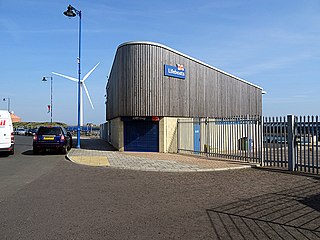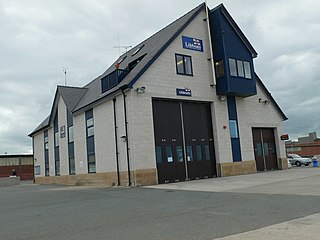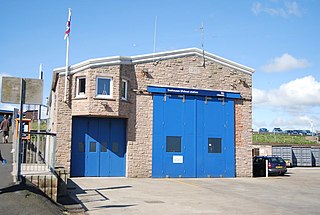
Tenby Lifeboat Station is a lifeboat station in Tenby, Pembrokeshire, Wales that has been situated to the east of the town since 1852, three generations having been built; the original and updates in 1905 and 2005. The station currently houses two lifeboats.

Walmer Lifeboat Station is located on The Strand on Walmer promenade, in the county of Kent.

Blyth Lifeboat Station is located at the Port and seaside town of Blyth, in the south east corner of the county of Northumberland, approx. 13 miles (21 km) north of Newcastle upon Tyne.

The Mumbles Lifeboat Station is at Mumbles Pier, located at the south-western corner of Swansea Bay, near the village of Mumbles, within the city and county of Swansea, in the historic county of Glamorgan, Wales.

Sennen Cove Lifeboat Station is the base for Royal National Lifeboat Institution (RNLI) search and rescue operations for the sea around Land's End, Cornwall in the United Kingdom. The first lifeboat was stationed at Sennen Cove in 1853. Since 2009 it has operated a Tamar-class all-weather boat (ALB) and a D-class (IB1) inshore lifeboat (ILB).

Fishguard Lifeboat Station in located on the quay, at the northern breakwater of Fishguard Harbour, in the community of Fishguard and Goodwick, in the county of Pembrokeshire, Wales.

Aldeburgh Lifeboat Station is located in the town of Aldeburgh, in the English county of Suffolk.

Rhyl Lifeboat Station is operated by the Royal National Lifeboat Institution (RNLI) in the North Wales town of Rhyl. For over 150 years, the Lifeboat Crew in Rhyl have been saving lives at sea. The first lifeboat was stationed in the town in 1852 and the present station was opened in December 2001. The station operates a Shannon-class All-weather lifeboat (ALB), and an D-class (IB1) Inshore lifeboat (ILB).

Cardigan Lifeboat Station is located at Poppit Sands, on the southern side of the River Teifi estuary in North Pembrokeshire, approximately 3 miles (4.8 km) north-west of the town of Cardigan, Wales.

Eastbourne Lifeboat Station is a Royal National Lifeboat Institution (RNLI) lifeboat station in the town of Eastbourne in East Sussex. Founded two years before the RNLI was established, the station has operated continuously since 1822, and its lifeboats have been responsible for saving over 700 lives.

Clovelly Lifeboat Station, serving the North Devon village of Clovelly and surrounding coastal waters, is run by the Royal National Lifeboat Institution (RNLI). It was established in 1870. The station is flanked by Appledore to the northeast and Bude to the southwest.

Plymouth Lifeboat Station is the base for Royal National Lifeboat Institution (RNLI) search and rescue operations at Plymouth in England. The first lifeboat was stationed in the city in the early 1800s. The station moved to its present site at Millbay Docks in 1992, a Grade II-listed three-storey tower. Since 2003 it has operated a Severn-class all-weather boat (ALB) along with an B-class Atlantic inshore lifeboat (ILB).

Tynemouth Lifeboat Station is located on the River Tyne, at Fish Quay, North Shields, in the county of Tyne and Wear.

Seahouses Lifeboat Station is located in the village of Seahouses, in the county of Northumberland.

Arbroath Lifeboat Station is located at the harbour town and former royal burgh of Arbroath, on the North Sea coast, 16 miles (26 km) northeast of Dundee, in Angus, Scotland.

Berwick-upon-Tweed Lifeboat Station is located on the south bank of the River Tweed at Tweedmouth, part of the town of Berwick-upon-Tweed, in the county of Northumberland.

Newcastle Lifeboat Station is situated at South Promenade, Newcastle, a seaside town in County Down, located the foot of Slieve Donard, the highest of the Mourne Mountains, overlooking the Irish Sea, in the south east corner of Northern Ireland.

Wexford Lifeboat Station is the base for a Royal National Lifeboat Institution (RNLI) inshore lifeboat at Wexford in Ireland.

Howth Lifeboat Station sits on the middle pier at Howth Harbour in the fishing village of Howth, on Howth Head, a peninsula located on the north side of Dublin Bay, in the administrative region of Fingal, historically County Dublin, on the east coast of Ireland.

Tramore Lifeboat Station is located on The Cove, near The Pier at Newtown, a suburb of Tramore, a seaside town in County Waterford, approximately 14 kilometres (8.7 mi) south of Waterford, on the south coast of Ireland.























